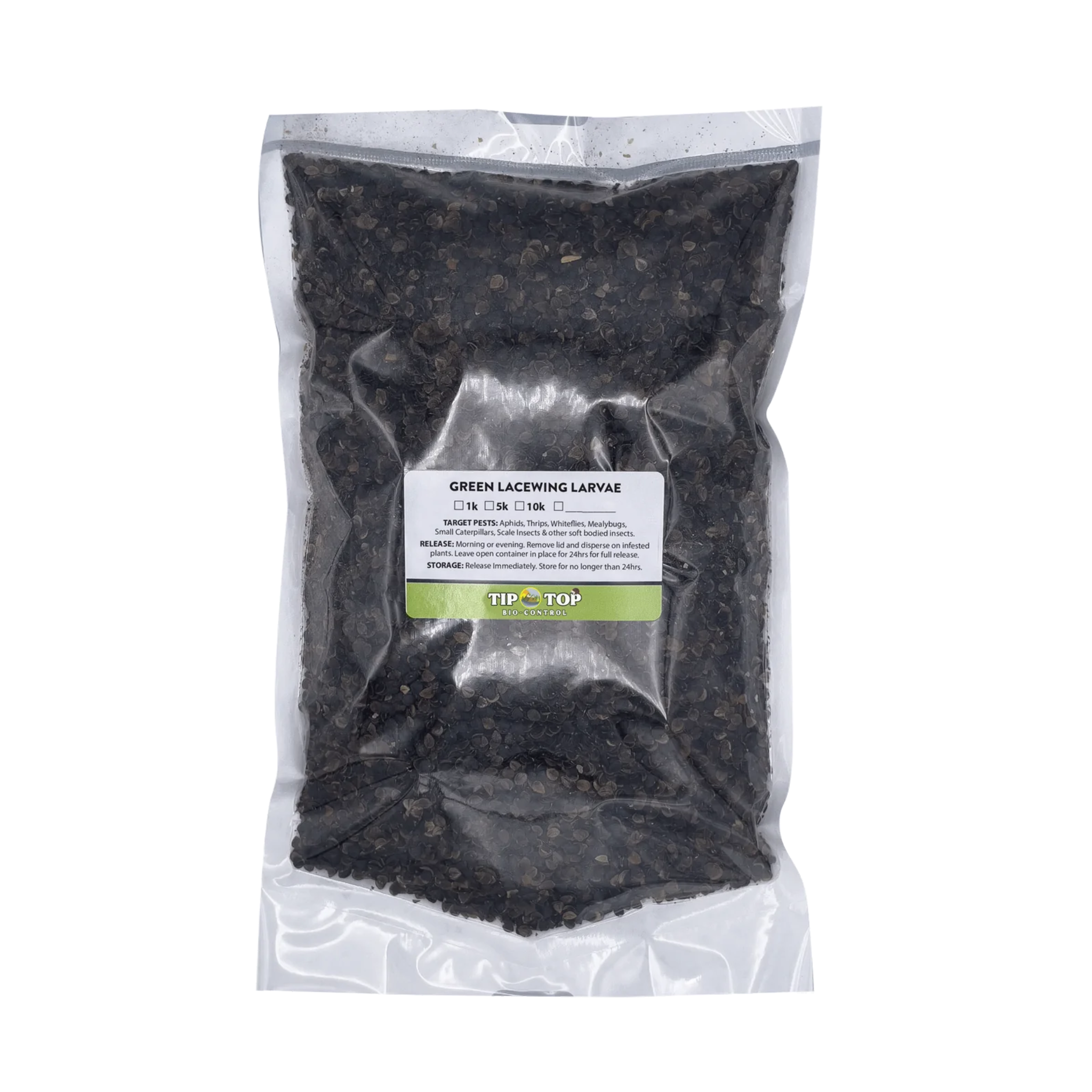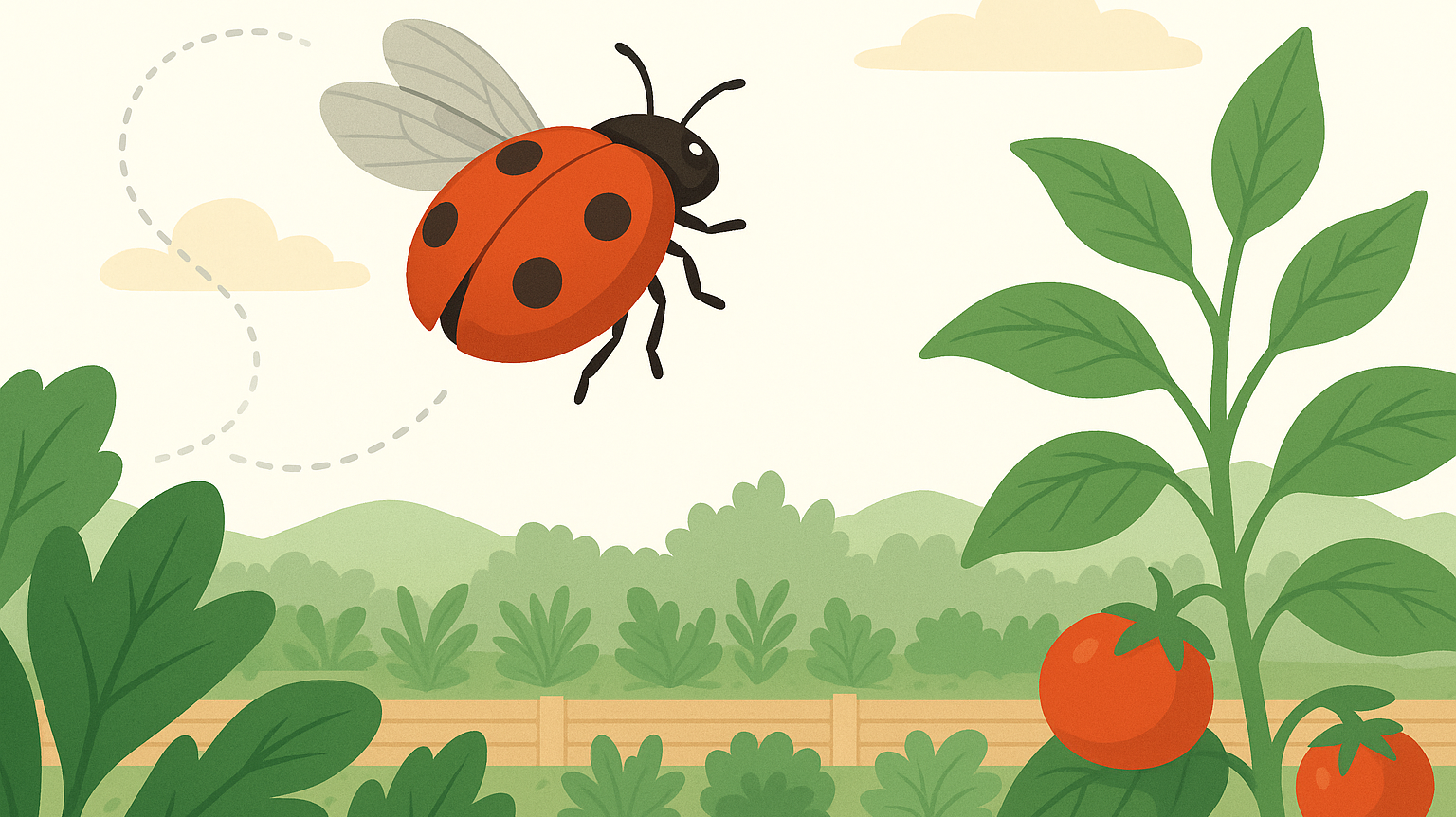Tired of Aphids on Your Plants? These Handle It for You.
Aphids multiply fast, hide in every crevice, and shrug off most sprays. If you’re looking for real treatment—without residue, resistance, or daily leaf-wiping—lacewing larvae are what you use.
Known as “aphid lions,” these predatory larvae feed nonstop on soft-bodied pests, including aphids, thrips, whiteflies, and more. No waiting. No fluff. Just efficient biological pest control that works on contact.
Green Lacewing Larvae (Live Hatch)
Biological Treatment for Aphids, Thrips, Whiteflies, and More
Each container contains incubated lacewing eggs—timed to start hatching around the time they arrive. Once hatched, the larvae begin hunting immediately.
You’re not getting delicate adults. You’re getting high-intensity predators ready to eat their way through pest colonies as soon as they hit the leaf.
What They Treat
| Pest | Stage Targeted |
|---|---|
| Aphids | All stages – primary target |
| Thrips | Larvae and adults |
| Whiteflies | Eggs, nymphs, adults |
| Mealybugs | Crawlers and soft-bodied stages |
| Spider mites | Opportunistic feeding |
| Fungus gnats | Adults only (limited control) |
Note: Lacewing larvae do not target hard scale or underground pests.
Why Lacewing Larvae for Aphids?
| Reason | What It Means |
|---|---|
| Fast suppression | Larvae feed immediately—no lag |
| No sprays or residue | Safe for food crops and ornamentals |
| Highly mobile hunters | They don’t wait for pests to come to them |
| Self-limiting | Cannibalistic—won’t overpopulate your space |
| Zero re-entry interval | Apply and walk away |
What's in the Container
-
Incubated green lacewing eggs
-
Timed to hatch shortly after shipping
-
Carrier: rice hulls, with emerging larvae mixed in
-
You may not see movement right away—release immediately on arrival
These are predators, not houseguests. If you wait too long, they’ll eat each other.
How to Use
-
Release immediately upon arrival
-
Gently scatter contents across affected plants
-
Leave the container open nearby for late hatchers
-
Do not refrigerate, soak, or mist
-
Avoid using any pesticide or foliar spray 7 days before or after release
Optional: Use a Good Bug Diet to sustain larvae if prey is scarce.
Application Rates
| Use Case | Rate |
|---|---|
| Preventative | 1 larva per sq ft, every 2 weeks |
| Active infestation | 250–500 for indoor setups, 1,000–5,000 per acre |
Repeat weekly during high-pressure periods or early in the plant cycle.
Life Cycle Snapshot
| Stage | Timing |
|---|---|
| Larvae | Hunt for 2–4 weeks |
| Pupation | Cocoon phase lasts 5–7 days |
| Adults | Emerge, mate, and lay new eggs if prey remains |
Larvae do the heavy lifting. Adults are beneficial but short-lived and less aggressive.
Storage
-
Use immediately for best results
-
If necessary, store at room temperature (65–75°F) for no more than 48 hours
-
Do not refrigerate or expose to direct sun
FAQ
How does the Live Guarantee work?
We know how important it is for your mites to arrive healthy and ready to work. That’s why we offer a live arrival guarantee—with flexible options depending on when we hear from you:
- Let us know within 24 hours of delivery: We’ll gladly send a free replacement shipment.
- Let us know within 2–3 days of delivery: We can offer store credit to make things right.
- After 3 days from delivery: Because these are living organisms, we’re not able to offer replacements or credit beyond that window. By then, it’s harder to know what went wrong or whether shipping conditions were a factor.
We truly want your mites to succeed—so please open your package as soon as it arrives and check on them. If something doesn’t look right, don’t wait—reach out and we’ll take care of you.
Where are you located?
We have a number of different locations in NJ, Maine and Oregon. While we'd love to have you, we are not currently open to the public.
Can I call you?
We get it. Sometimes it's easier to talk to someone, and on a case by case basis we can try to figure it out. Unfortunately though, we're really not able to take calls—FGMN is a small nursery, and we're usually elbows-deep in plants or packing boxes. To make sure nothing gets missed (and everyone gets a timely reply), we keep all communication in writing.
Feel free to message us at info@fgmnnursery.com. We mostly respond quickly, but every once in awhile replies may take a day. Do follow-up if you don't hear in that time. We're human, we miss an email here or there.
Too Many Options?
We get it. Try our mite/insect matchmaking quiz and instantly get matched to the solutions you may need.
Our Live Delivery Guarantee
We stand behind every leaf and every mite. If your plant or predatory insects don’t arrive alive on the first delivery attempt, we’ll make it right.
Here’s what you need to know:
- Email us at info@fgmnnursery.com within 24 hours of delivery
- Include clear photos of the item and the shipping label
- Someone must be available to receive the package—plants and bugs don’t do well sitting in the sun, a mailbox, or the back of a delivery truck
For plants, we offer store credit if something goes wrong.
For predatory mites and beneficial insects, you’ll have the choice of a replacement shipment or store credit.
If you contact us after the 24-hour window, we may still be able to help—just know it’s handled case by case.
We pack with care, insulate when needed, and check the weather before shipping. But once it’s in transit, the fastest way to protect your order is to open it right away.
Mite Matters
The Hidden Weather That Shapes Plant and Predator Life
Invisible weather shapes every growing space. Warm air pools under lights, cool air settles near the floor, and in between, tiny predators decide where they’ll thrive. Learn how microclimates influence the balance between plants, pests, and the mites that keep them in check.
If Ladybugs Are Just Going to Fly Away, Why Use Them?
Most ladybugs don’t fly off out of spite — they leave when the environment isn’t right. Learn how temperature, humidity, and shelter affect whether they settle or scatter, and how to create the ideal setup that keeps them working where you need them most.
Where Did My Predatory Mites Go?
Released predatory mites but can’t see them anymore? Don’t panic. Their invisibility is exactly what makes them effective. Learn why they vanish, how they hunt pests out of sight, and why reapplying keeps your plants protected.












